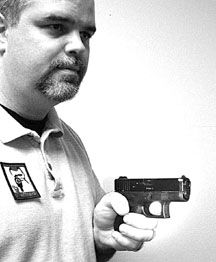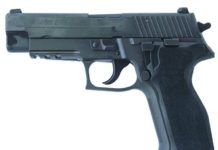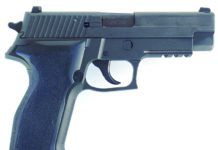
Last month we tested two subcompact 9mm pistols that, based on the shared technology of polymer construction and striker-fired actions, were set to compete with the Glock Model 26. This month we take a look at Taurus’s .40 S&W Millennium Pro 140SSP, matching it against Glock’s subcompact, the GL27. The GL 27 and the Taurus pistols are almost identical to the 9mm handguns we tested previously, and we were particularly interested in how the .40s would stand up against the abuse the stouter S&W round delivers.
In the past, high-cap polymer 9mm semi-auto designs and frames rechambered for.40 S&W have not always shouldered the extra energy load too well. Structural failures sent many manufacturers back to the drawing board. Problems in polymer and steel-framed guns alike included cracked frames and slides and jumbled internal mechanisms.
Besides questions about durability, we also wanted to explore the operational differences between these two pistols. Would shooters be able to use the same techniques to ensure fast, accurate hits, or would the guns be so different that we would be forced to shoot them differently?
Here’s what we found when we tested the Glock 27, $641; and the Taurus PT140 Millennium Pro 140SSP, $485, side by side:
[PDFCAP(1)]All the Glock pistols operate the same. You simply press the trigger. While some people deride this system as unsafe, it is no different than the operation of a double-action revolver. Indeed, this simplicity is what many celebrate about the Glock system.
The main features of the 27 are its short barrel and reduced grip area. The smaller grip offers a more concealable profile that won’t print on one’s clothing. To make up for the smaller grip, most subcompact pistols come with a finger groove mounted on the base pad of the magazine. Because this “lip” extends the face of the frontstrap, the additional mass rarely interferes with concealment. We did not mind this feature missing from the 9mm Model 26, but the kick of .40 S&W in the GL27 interfered with our concentration. Glock subcompacts do not come with any sort of finger extension, and we think this gun needed one. (Pearce makes a good Glock magazine base pad, available for $8.95 from Natchez Shooters Supplies, 800-251-7839).
Nevertheless, at the public range where we conducted our tests we conducted a casual poll regarding this point. To the Glock’s credit, we could find no one who was willing to give up on this pistol as a concealment piece because of the stubby little grip. The bottom line: Shooters were willing to deal with the shortcomings of the 27 in exchange for its 8+1 firepower.
We tested each gun for accuracy from a sandbag rest at 15 yards, but we think [PDFCAP(2)] does not tell the whole story. In the case of the Glock subcompact we found it very difficult to establish a quality hold at the bench. The shortened grip and frame combined with recoil from the .40 S&W ammunition limited our setup on the rest and interfered with follow through. The GL27 was designed as a defensive pistol, and it is much easier to shoot while standing unsupported.
Nevertheless, results from the bench were good enough to achieve an average five-shot group measuring less than 3 inches with two out of our three choices of ammunition. The little Glock liked the Black Hills 155-grain hollowpoints the best. In fact the average group size was slightly smaller than those achieved with the Taurus Millennium Pro, but the extreme spread from largest to smallest sized group was greater. Also, the Glock ran without flaw no matter what ammunition we used. This included jacketed and hollowpoint ammunition, both factory and handloaded, from Aguila, Winchester, Remington, Remington UMC, Black Hills and MagTech in bullet weights from 155 to 200 grains.
[PDFCAP(3)]There are currently twelve versions of the Millennium Pro series, according to Taurus’s website. There are four 9mms, four .40 S&Ws, and four .45 ACP models. Of the four .40s, two have blued finishes and two have stainless slides, the 140SSP and the 140SSPNS. Our gun was the 140SSP, which features a three-white-dot sighting system, but not “night sights,” which add the letters “NS” to the gun’s designation.
The Millennium Pro pistol is markedly different from the Millennium or PT series pistols before it. The primary difference is the shape of the grip. A generous palm swell is the most obvious change, and this new grip prevents it from sharing magazines with the earlier models. The magazine (only one is provided) was supposed to hold 10 rounds, but we were only able to jam in nine.
The Millennium series pistols also differ significantly from other polymer handguns. Unlike other designs, in which the slide is connected to the frame with steel contact points inserted into the polymer, the Taurus Millennium features an aluminum subframe. To remove the top end, the shooter first locks back the slide. Then he takes out a slide stop, similar to a Browning 1911 design. This is unusual because most other polymer pistols, the Glock included, are taken apart by moving a lever that stays with the gun. With the top end removed, the Taurus looks like the typical metallic-framed pistol with long frame rails exposed. In fact the subframe offers about 15 times more contact area between the frame and slide than the Glock design.
We believe that lockup contributed to the Pro outshooting the Glock at the range — but we also took into account ergonomics that made the Taurus easier to shoot off the bench. The ideal Taurus load turned out to be the Winchester USA 165-grain FMJ round. We fired a nine-shot group (one complete magazine) into an area that measured about 2.2 inches. This topped the Glock’s best nine-shot group of 3.0 inches firing the 180-grain FMJ round.
Our Millennium Pro came with a matte stainless steel slide, an upgrade from the standard blued-steel model. The Millennium Pro uses a left-side thumb-operated safety like that found on earlier models. This feature is a helpful addition. There is also a key-operated lock on the right side of the slide.
Despite their similarities, the Pro and the Glock 27 were very different guns once they were loaded. The fact that they both featured polymer construction and striker firing didn’t much matter when we tallied up the differences in the way these guns shot. In the course of our tests we do not begin to record accuracy data until we have familiarized ourselves with a gun. In testing these two pistols, we found that what was required for success with one gun did nothing to prepare us for shooting the other. The Glock trigger, for example, used a short throw that broke cleanly and repeatedly without warning. Holding the gun level to be ready for the shot was key, despite it not offering much to hold on to. Convincing us that two fingers on the grip was enough was probably the biggest mental challenge. The Taurus, in contrast, was a dream to hold. The only problem was the trigger was so long and vague that it took a lot of attention to maintain a level gun while waiting for the shot. The most common mistake was letting the gun dip just as the shot let off. We did learn to expect an inordinate amount of take-up between shots, but we thought the Glock was a more willing participant in rapid-fire drills. For us, this is telling: That’s what self-defense is all about.
The Millennium Pro is an improvement over previous models, but a shorter trigger with more feedback would put this handgun over the top. Indeed, the Millennium Pro already has a mechanical safety, so why not adopt a more sensitive trigger that will make it easier to operate? For now we think the Millennium Pro is a budget pistol with some excellent features — but a lot more potential. Should future models offer an improved trigger, Taurus might then be able to mount a serious challenge to Glock.
Gun Tests Recommends
Glock Model 27 .40 S&W, $641. Buy It. Our only real complaint with this gun is its abbreviated grip, and that can be solved for less than $10. The GL27 is as handy as it is powerful.
Taurus PT140 .40 S&W Millennium Pro 140SSP, $484. Conditional Buy. At well under $500, this pistol offers good concealable firepower. But we think its defensive capabilities would be vastly improved with a shorter, more precise trigger backed by its mechanical safety. We would wait to see if Taurus follows up with this improvement.




























